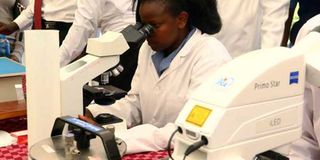KMTC opens campuses in counties to plug health staff gap

A student tests new equipment at KMTC Nakuru campus. The country’s premier healthcare training facility has expanded its campuses to various counties in Kenya.
What you need to know:
From only 28 campuses five years ago, it has 66 in 43 counties.
This has seen the number of student applicants grow to more than 35,000 per year.
World Bank has sponsored the training of 800 enrolled community health nurses from marginalised communities.
As the 8,967 young, ambitious and energetic graduates walk out of the Kenya Medical Training College (KMTC) Thursday, it will be another milestone in the bridging of the healthcare worker deficit in Kenya.
The staff shortage has been a major cause for concern for the government given the steady increase in population.
Investment in healthcare facilities at the county level to improve access to healthcare services among Kenyans has been met with the lack of trained healthcare workers.
That is the main reason why the country’s premier healthcare training facility has expanded its campuses to the counties, said the KMTC CEO Peter Tum.
From only 28 campuses five years ago, it has 66 in 43 counties.
This has seen the number of student applicants grow to more than 35,000 per year.
STUDENTS
This year, the institution has enrolled 12,000 medical students — double the usual number, considering that it has maintained a maximum of 6,000 students per year over the past five years.
KMTC provides more than 80 percent of the healthcare workforce in Kenya and, with the government’s expansion of health facilities, there is a high demand for medical personnel, which the institution is keen to halve by 2025.
This has set KMTC on a pedestal, such that it has to chase after the government by training more medical personnel, said the CEO.
DONORS
For this reason, donors have showed up eager to help KMTC to work in tandem with the government.
For instance, the World Bank has sponsored the training of 800 enrolled community health nurses from marginalised communities in far-flung areas.
This will help the country to cope with the healthcare challenge in human resources for health (HRH).
The other purpose of the expansion is to cater for the education needs of the youth. It assures Kenyans universal health when KMTC trains medical workers with the right skills and attitude. On this front, KMTC leads with 18 training programmes in medicine and health.
To cater to the needs of emerging and re-emerging diseases, KMTC has designed new post-graduate programmes in nephrology, anaesthesia, trauma medicine and several others.
LOOK OUTSIDE
The expansion has not been without challenges, however.
“Although the government pays for the training of human resources, for our facilities and infrastructure we have to really look outside,” said Mr Tum.
Besides, local universities and colleges have been expanding, eating into KMTC’s market share.
To implement this ambitious expansion strategy, KMT has entered into memorandums of understanding with county governments.
“County governments provide the infrastructure and facilities while we provide the faculty, training and equipment and we train,” said Mr Tum.
The MoUs’ give-and-take aspect is that KMTC trains 30 per cent of students from the host county in every intake.
EMPOWER COUNTIES
This also empowers the counties because personnel trained at the devolved units are able to comfortably work under their unique conditions.
“Take, for instance, those trained in Laikipia and Mandera,” Mr Tum explained.
“It would be easier for them to be absorbed within their local zones because they better understand the in-county challenges and can fit well there, rather than posting personnel from other regions.”
In far-flung areas such as Mandera, the demand for human resource in health is very high.
The government’s Equalisation Fund has also provided resources towards this expansion, to which Mr Tum said: “Through this, we have been able to establish campuses in Taita-Taveta, Isiolo, Mandera, Lamu, Mtwapa and Hola. We now want to expand to Garissa.”
Eventually, the expansion will ensure every county has a medical training college, he added.
“That is why we have established campuses in Oloitoktok, Kapenguria, Marsabit and Kwale,” said Mr Tum.





